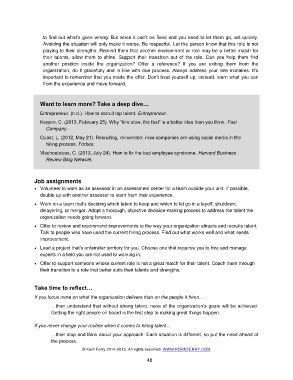Page 48 - kf fyi for your improvement license eng 3-4-15
P. 48
to find out what’s gone wrong. But when it can’t be fixed and you need to let them go, act quickly.
Avoiding the situation will only make it worse. Be respectful. Let the person know that this role is not
playing to their strengths. Remind them that another environment or role may be a better match for
their talents, allow them to shine. Support their transition out of the role. Can you help them find
another position inside the organization? Offer a reference? If you are exiting them from the
organization, do it gracefully and in line with due process. Always address your hire mistakes. It’s
important to remember that you made the offer. Don’t beat yourself up; instead, learn what you can
from the experience and move forward.
Want to learn more? Take a deep dive…
Entrepreneur. (n.d.). How to recruit top talent. Entrepreneur.
Kerpen, C. (2013, February 25). Why “hire slow, fire fast” is a better idea than you think. Fast
Company.
Quast, L. (2012, May 21). Recruiting, reinvented: How companies are using social media in the
hiring process. Forbes.
Vlachoutsicos, C. (2013, July 24). How to fix the bad employee syndrome. Harvard Business
Review Blog Network.
Job assignments
• Volunteer to work as an assessor in an assessment center for a team outside your unit. If possible,
double up with another assessor to learn from their experience.
• Work on a team that’s deciding which talent to keep and which to let go in a layoff, shutdown,
delayering, or merger. Adopt a thorough, objective decision-making process to address the talent the
organization needs going forward.
• Offer to review and recommend improvements to the way your organization attracts and recruits talent.
Talk to people who have used the current hiring process. Find out what works well and what needs
improvement.
• Lead a project that’s unfamiliar territory for you. Choose one that requires you to hire and manage
experts in a field you are not used to working in.
• Offer to support someone whose current role is not a great match for their talent. Coach them through
their transition to a role that better suits their talents and strengths.
Take time to reflect…
If you focus more on what the organization delivers than on the people it hires…
…then understand that without strong talent, none of the organization’s goals will be achieved.
Getting the right people on board is the first step to making great things happen.
If you never change your routine when it comes to hiring talent…
…then stop and think about your approach. Each situation is different, so put the need ahead of
the process.
© Korn Ferry 2014-2015. All rights reserved. WWW.KORNFERRY.COM
48

